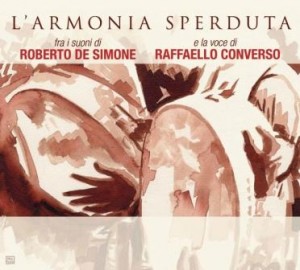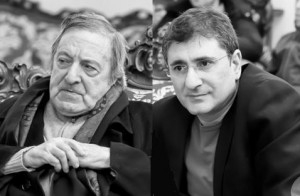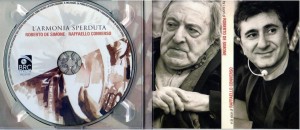 Zeus Record & Proscenio presentano
Zeus Record & Proscenio presentano
L’Armonia Sperduta
fra i suoni di Roberto De Simone
e la voce di Raffaello Converso
Il presente prodotto discografico è la realizzazione di un triennale progetto meditato sulla Canzone Napoletana, e messo in opera dalla collaborazione fra il M° Roberto De Simone e il cantante Raffaello Converso.
Si tratta di un ideale e progressivo percorso stilistico che, sorvolando sui prodotti relativi alla musica leggera, conduce alle più innovative contaminazioni linguistiche dei trascorsi anni 70.
 Renato Piemontese Direttore
Renato Piemontese Direttore
Mimmo Napolitano Pianoforte
Fabrizio Falasca Violino I°
Gianluca Falasca Violino II°
Marco Traverso Viola
Leonardo Massa Violoncello / Calascione
Ottavio Gaudiano Contrabbasso
Giuseppe Di Colandrea Clarinetto / Clar. Basso / Sax Soprano
Luciano Nini Sax Contralto / Sax Tenore
Luca Martingano Corno
Francesco Amoroso Tromba
Maurizio Tedesco Trombone
Umberto Leonardo Chitarra
Edoardo Converso Mandolino
Nico Berardi Zampogna / Flauti etnici / Charango
Gianluca Mirra Percussioni
Federica Santoro Lira Calabrese
Angelo Pisani Marranzano / Fischiotti
Filippo D’Allio Chitarra Elettrica
Luigi Sigillo Basso elettrico
Si ringraziano : Paolo Romano Shaone per la partecipazione nel brano Palummella
Antonello Paliotti, chitarra battente nei brani Palummella, Tarantella per Wagner e Je so’ pazzo
Brunello Leone per la voce di Pulcinella nel brano ‘O Surdato nnammurato
Biagio Abenante per il coro in Dove sta Zazà?
Prodotto da Zeus Record e Raffaello Converso
Elaborazioni ed Orchestrazioni Roberto De Simone
Produzione artistica Raffaello Converso
Registrato presso gli studi della Zeus Record
Ingegnere del suono Espedito Barrucci
In copertina opera di Gennaro Vallifuoco
Fotografie Antonio Corbi – Andrea Cataldo – Peppe Ruotolo

Da considerazioni e confronti condotti sul vasto panorama della Canzone napoletana, desumiamo che esso non può riferirsi esclusivamente a poeti e musicisti che hanno agito produttivamente a Napoli nell’arco storico di circa un secolo. I documenti stampati della ingente mole di composizioni musicali, difatti, sottintendono una oralità esecutiva che preesisteva alla Canzone stessa e che ne ha consentito la popolarità.
Mi riferisco a quelle prassi vocalistiche che nei secoli distinguevano a Napoli il canto popolareggiante la cui struttura, spaziando in ambiti melodici ben più ampi del canto etnico e agendo in tessiture vocali diverse, aveva determinato una caratterizzazione identificativa mediante una ricchezza esecutiva di fioriture, di emissioni strisciate, di appoggi sillabici, di contaminazioni, di fratture verbali e una libertà ritmica, indipendente dai valori mensurali dell’indicazione scritta o dell’andamento regolare del brano.
In esecutori come Gilda Mignonette, Sergio Bruni, Enzo Romagnoli, Maria Paris, Eva Nova e in altri, il riferimento a tale tradizione è palese, pur aggiungendo essi la loro identità vocale e il colore timbrico altamente riconoscibile, che ne evidenziavano la personalità artistica.
Ma nei cantatori detti posteggiatori il rapporto tra stile e prodotto letterario musicale, appariva talvolta contraddittorio ma più che mai evidente. Tali esecutori, in gran parte analfamusici – a dire di Diego Carpitella – facevano capo a rudimentali documenti stampati in cui la scrittura era sinteticamente ridotta alla parte melodica ( le cosiddette copielle riservate al canto o alle linee mandolinistiche e violinistiche ).
L’accompagnamento armonico era determinato dalla sensibilità di chitarristi a braccio che, senza tener conto del rispetto rigoroso della battuta, producevano appoggi desunti dal bagaglio delle loro esperienze, ed essenziali al fraseggio libero dei cantatori.
Il complessivo prodotto esecutivo mostrava esiti di totale appartenenza a una collettività ben distinta ed espressivamente inequivocabile.
Oggi, sparito questo ponte linguistico, la Canzone stessa può dirsi esaurita o storicamente trascorsa.
Orbene, Raffaello Converso, esecutore vocale di repertori tradizionali, come figlio di uno degli ultimi cantanti posteggiatori, ha accumulato, accompagnando spesso il padre con la chitarra, un cospicuo bagaglio di esperienze per quel che riguarda lo stile della Canzone partenopea e i moduli che la connotavano. La presente produzione discografica ha inteso quindi valersi di tali esperienze, sebbene in modo critico, senza ricalcare pedissequamente i modelli paterni e tradizionali.
Per quel che mi riguarda, ovviamente, non ho mai progettato di scrivere degli arrangiamenti per le esecuzioni qui prodotte. Al contrario, ho agito compositivamente, a simiglianza di quei chitarristi di posteggia, apponendo al canto armonie desunte dalle mie esperienze strawinskiane, bartokiane, weilliane, pergolesiane.
La contaminazione storica, che pur connota la più autentica tradizione nostrana, è stata la mia principale meta, sorvolando sulla banale veste strumentale di armonia scolastica.
In sottotraccia mi son sempre riferito ad ardite associazioni mentali, relative alla storia e allo straniamento musicale con cui agivano i veraci esecutori ricchi di memoria orale.
Roberto De Simone
![]() Lost harmonies
Lost harmonies
With music by Roberto De Simone
and the voice of Raffaello Converso
When considering the vast spectrum of the Canzone napoletana – the Neapolitan song – it is clear that we do not only mean those artists who were active as poets and musicians in Naples over the course of a century. The enormous numbers of surviving printed compositions show the existence of a rich vocal culture before the Canzone, on which its popularity is founded.
Over the centuries, there were certain vocal practices that made Neapolitan popular song distinctive. Its structure, more wide-ranging melodically than folk song and using different vocal ranges, was characterized by a wealth of ornamentation, sliding delivery, unusual syllabic stresses, outside influences, fractured words and a rhythmic freedom that took little account of the written notation or the regular progression of the piece.
Artists such as Gilda Mignonette, Sergio Bruni, Enzo Romagnoli, Maria Paris, Eva Nova and others make obvious reference to this tradition while enriching their performances with a personal vocal style and unmistakable timbre that expressed their own artistic personality.
In the case of the so-called posteggiatori , the Neapolitan singers or “cantatori”, although the relationship between vocal style and the literary-musical product sometimes seemed inconsistent, it was more than obvious. For the most part, these performers did not read music – see Diego Carpitella – and relied on rudimentary sheet music that sketched out the melody (so-called copielle with only the vocal line or the mandolin and violin parts).
The harmonic accompaniment succeeded thanks to the sensitivity of the improvising chitarristi a braccio and their wealth of musical experience. Without slavishly adhering to the beat, they provided the essential foundation that gave the artist the freedom to phrase the melody line as desired.
This exceptional, unique form of performance left no doubt as to its relationship with the true “cantatori napoletani”.
Today, in the absence of this musical interaction, the culture of the Canzone napoletana has virtually dried up and is no longer contemporary.
Raffaello Converso, son of one of the last posteggiatori and now a singer of the traditional repertoire, often accompanied his father on the guitar, thus gathering extensive experience with the style of the Neapolitan song and its characteristic elements. This CD has greatly benefited from these experiences – while not uncritically accepting traditional models or merely imitating them.
I never intended to write simple arrangements for this material. Instead, my contribution is of a compositional nature, resembling that of the chitarristi a braccio: I complement the vocal lines with harmonies derived from my experiences with the music of Stravinsky, Bartok, Weill and Pergolesi.
My overriding objective was to enrich these songs with elements from eras that represent our most authentic musical tradition – rather than to accompany them only with elementary academic harmonies.
My work has been informed throughout by daring mental associations, drawing on the form’s history and the delight in the musically unusual that is typical of the true performers of the oral tradition.
Robert De Simone
________________________________________
1. Posteggiatore > Musicians who spontaneously performed in public places such as restaurants or plazas.
2. Copielle > Printed copies of Neapolitan songs sold at roadside stalls; their price was well below that of music released by publishing houses.
3. Chitarrista a braccio > Guitarists who improvised the accompaniments to the cantatore’s songs.
translation Elizabeth Gahbler
![]() Die verloren gegangene Harmonie
Die verloren gegangene Harmonie
mit den Klängen von Roberto De Simone
und der Stimme von Raffaello Converso
Wenn man das weite Spektrum der Canzone napoletana, des neapolitanischen Liedes, betrachtet, dann erkennt man, dass nicht nur jene Interpreten gemeint sind, die im Laufe eines Jahrhunderts in Neapel als Poeten und Musiker wirkten. Die ungeheure Menge an heute noch existierenden gedruckten Kompositionen zeigt uns, dass es bereits vor der Canzone eine reiche Gesangskultur gegeben hat, die deren Popularität bereits begründete.
Ich meine hier jene Gesangskultur, die das volkstümliche Liedgut in Neapel über Jahrhunderte prägte. Melodisch ging sie über die Grenzen des Volksliedes hinaus und orientierte sich an unterschiedlichen Gesangsmustern, indem Sie aus einem großen Repertoire an musikalischen Verzierungen schöpfte: Charakteristika der Canzone napoletana waren eine syllabische Akzentuierung, ziehende, „schluchzende“ Laute, eine Vielzahl an musikalischen Elementen verschiedener Epochen, zerrissen oder brüchige wiedergegebene Worte und eine rhythmischen Freiheit jenseits der Notenwerte des geschriebenen Stückes oder dessen regulären Verlauf.
Durch Künstler wie Gilda Mignonette, Sergio Bruni, Enzo Romagnoli, Maria Paris, Eva Nova und andere wird der Bezug zu dieser Tradition offensichtlich, auch wenn deren Darbietungen natürlich ebenso durch ihren persönlichen Gesangsstil und das unverwechselbare Kolorit der Stimme als Ausdruck ihrer künstlerischen Persönlichkeit bereichert wurde.
Im Falle der sogenannten posteggiatori , der neapolitanischen Sänger bzw. „cantatori“, erschien der Zusammenhang zwischen Gesangsstil und literarisch-musikalischem Produkt zwar manchmal widersprüchlich, war jedoch mehr als offensichtlich. Diese Musiker, die zum großen Teil keinerlei musikalische Ausbildung hatten – siehe Diego Carpitella –, stützten sich auf rudimentäre Druckwerke mit einfacher Wiedergabe der Melodie (die sogenannten copielle , die nur den Gesang oder die Mandolinen- und Geigenpartien wiedergaben).
Die harmonische Begleitung gelang dank dem Einfühlungsvermögen der improvisierenden chitarristi a braccio und deren Repertoire an musikalischer Erfahrung. Ohne sich streng an den Takt zu halten, boten sie dem Interpreten den Rückhalt, der für seine freien Phrasierungen wesentlich war.
Die außergewöhnliche und unverwechselbare Form der Darbietung ließ keinen Zweifel an der Zugehörigkeit zu den echten „cantatori napoletani“ aufkommen.
Heute, da dieses musikalische Zusammenspiel verloren gegangen ist, ist die Kultur der Canzone napoletana praktisch versiegt und nicht mehr zeitgemäß
Raffaello Converso, Sänger traditioneller Repertoires, begleitete als Sohn eines der letzten posteggiatori seinen Vater oft mit der Gitarre und sammelte dabei weitreichende Erfahrungen zum Stil des neapolitanischen Liedes und dessen kennzeichnender Elemente. Mit der vorliegender CD ist es gelungen, diese Erfahrungen – wenn auch nicht kritiklos – zu nutzen, ohne dabei die väterlichen und traditionellen Vorgaben sklavisch nachzuahmen.
Ich wollte hier nicht nur einfache Arrangements zu diesen Liedern schreiben. Mein Beitrag ist vielmehr kompositorischer Natur, ähnlich dem der chitarristi a braccio: Ich untermale den Gesang mit Harmonien, die meinen Erfahrungen mit der Musik von Strawinsky, Bartok, Weill und Pergolesi entspringen.
Mein vorrangiges Ziel war die Bereicherung mit Elementen aus unterschiedlichen Epochen, die auch das Kennzeichen unverfälschter italienischer Musikkultur ist, wodurch ich sozusagen über die einfache Harmonie hinaustrete.
Im Grunde hatte ich bei meiner Arbeit stets jene „echten“ Musiker vor Augen, die aus einem reichen Repertoire an mündlicher Überlieferung schöpften und so zu gewagten, außergewöhnlichen musikalischen Kombinationen fanden.
Roberto De Simone
_____________________________________________
1. posteggiatore > Musiker, der spontan an öffentlichen Orten, z.B. in Restaurants, auf Plätzen, auftrat.
2. copielle > Kopien der neapolitanischen Musikstücke, die an Straßenständen verkauft wurden; ihr Preis lag weit unter dem der vom Verlag veröffentlichten Partitur.
3. chitarrista a braccio > Gitarrist, der improvisierend, d.h. aus dem Stegreif, den Gesang des cantatore begleitete.
Übersetzung Elvira Vogt
![]() La armonía perdida
La armonía perdida
Entre los sonidos de Roberto de Simone
y la voz de Raffaello Converso
A partir de consideraciones y comparaciones dentro del vasto panorama de la Canzone napolitana concluimos que
el término no puede referirse exclusivamente a poetas y músicos que han actuado productivamente en Nápoles en
los últimos cien años. Existen documentos estampados de una enorme cantidad de composiciones musicales, los
cuales implican una cultura oral que precedía a la Canzone y que permitió su popularidad.
Me refiero a aquellas prácticas vocales que en su época distinguían al canto popular dentro de Nápoles, cuya
estructura se desempeñaba en ámbitos melódicos mucho más amplios que los del canto étnico y se desarrollaba
en registros vocales diversos, determinando una caracterización identificativa mediante una riqueza suntuosa,
llena de acentuaciones propias, de contaminaciones, de fracturas verbales y de una libertad rítmica independiente
de los valores regulares, de las indicaciones escritas y de las tendencias del estilo.
A través de artistas como Gilda Mignonette, Sergio Bruni, Enzo Romagnoli, Maria Paris y Eva Nova, entre otros, se
hace evidente el vínculo a esta tradición, aun cuando ellos incorporan su identidad vocal y los colores
inconfundibles de su canto, los cuales evidencian una personalidad artística única.
La relación entre estilo y producto literario musical en los cantantes conocidos como posteggiatori, aparecía a
pesar de sus contradicciones, más evidentemente que nunca. Estos artistas, en gran parte analfamúsicos – véase
Diego Carpitella – se apoyaban en documentos rudimentarios cuyas partituras habían sido reducidas meramente a
la parte melódica (las llamadas copielle, reservadas al canto o a las líneas para mandolina y violín).
El acompañamiento armónico era determinado por la sensibilidad de los guitarristas a braccio, que sin tener en
cuenta el rigor de los tiempos marcados por una batuta, producían un apoyo esencial al verso libre de los
cantantes gracias al bagaje de sus propias experiencias musicales.
Este conjunto musical no deja lugar a dudas de su pertenencia a un colectivo diverso y expresivamente
inconfundible.
Hoy en día, habiendo desaparecido este puente lingüístico, la Canzone puede ser catalogada como un género
histórico, gastado o anticuado.
Sin embargo, Raffaello Converso, cantante de repertorios tradicionales, hijo de uno de los últimos cantantes
posteggiatori, ha acumulado, tras acompañar frecuentemente a su padre con la guitarra, un rico bagaje de
experiencias relacionadas con el estilo de la Canzone partenopea y con sus elementos característicos. La presente
producción discográfica pretende valerse de estas experiencias, si bien en un modo crítico, sin recalcar los modelos
paternos y tradicionales.
En lo que concierne a mi persona, obviamente, no he aspirado jamás a escribir arrangiamenti para este tipo de
piezas. Al contrario, he ejercido el papel de un compositor semejante a aquellos guitarristas a braccio, agregando
al canto armonías provenientes de mis experiencias strawinsquianas, bartoquianas, weillianas y pergolesianas.
La contaminación histórica, aunque connote nuestra más auténtica tradición, fue mi meta principal. Así mismo lo
fue el dejar a un lado la banalidad del arreglo instrumental de armonía escolástica.
En retrospectiva, siempre me he orientado a partir de atrevidas asociaciones mentales, relacionadas a la historia y
a la combinatoria musical de las cuales se servían los veraces artistas enriquecidos por una memoria oral colectiva.
Roberto De Simone
traducción Claudia Laya/Andreas Hettmann
![]() L’harmonie perdue
L’harmonie perdue
entre les sons de Roberto De Simone
et la voix de Raffaello Converso
Après avoir fait de justes considérations et comparaisons sur le vaste panorama de la Chanson Napolitaine, on en déduit qu’il ne peut pas se rapporter exclusivement aux poètes et aux musicistes qui ont été productifs à Naples dans la période d’environ un siècle. Les documents imprimés de la quantité considérable de compositions musicales, en effet, sous-entendent des exécutions orales qui préexistaient à la Chanson même et qui en ont permis la popularité.
Je me rapporte à ces pratiques de vocalismes qui, au cours des siècles, distinguaient à Naples le chant qui imite l’art populaire, la structure duquel, embrassant de domaines mélodiques beaucoup plus amples que le chant ethnique et agent en textures vocales différentes, avait déterminé une caractérisation identificative grâce à une richesse exécutive en fioritures, en émissions sifflées, en appuis syllabiques, en contaminations, en ruptures verbales et une liberté rythmique indépendante des valeurs de durée des indications écrites ou du mouvement régulier du morceau musical.
La référence à telle tradition est manifeste en exécutants comme Gilda Magnonette, Sergio Bruni, Enzo Romagnoli, Maria Paris, Eva Nova et d’autres, même s’ils ajoutent leur identité vocale et la couler de leur timbre hautement reconnaissable, qui en mettaient en évidence leur personnalité artistique.
Mais pour les chanteurs dits posteggiatori (musiciens ambulants qui se produisent en restaurants ou cafés) le rapport entre le style et le produit littéraire musical paraissait parfois contradictoire mais plus que jamais évident. Ces exécutants, qui ne connaissaient pas la théorie musicale, en grande partie – au dire de Diego Carpitella – consultaient de rudimentaires documents imprimés dans lesquels l’écriture était synthétiquement réduite à la partie mélodique (les soi-disant copielle réservées au chant ou aux lignes de la mandoline et du violon).
L’accompagnement harmonique était déterminé par la sensibilité des guitaristes a braccio qui, sans faire attention au respect rigoureux de la mesure, produisaient des appuis déduits du bagage de leur expériences, et essentiels pour le phrasé libre des chanteurs.
Le produit exécutif global montrait un résultat d’appartenance totale à une collectivité bien distincte et expressivement non équivoque.
Aujourd’hui, ce pont linguistique a disparu, et la Chanson même peut se dire épuisée ou historiquement passée.
Eh bien, Raffaello Converso, exécutant vocal de répertoires traditionnels, comme fils d’un des derniers chanteurs posteggiatori, a accumulé, accompagnant souvent son père à la guitare, un gros bagage d’expériences en ce qui concerne le style de la Chanson Parthénopéenne et les modules qui la connotaient. La production discografhique présente veut se valoir de ces expériences, même si dans une façon critique, sans marcher servilement sur les traces des modèles paternels et traditionnels.
En ce qui me concerne, évidemment, je n’ai jamais projeté d’écrire des arrangements pour les exécutions ici produites. Au contraire, j’ai crée de nouvelles compositions, regardant ces guitaristes de posteggia, apposant au chant des harmonies acquises par mes expériences de Stravinsky à Bartok, de Weill à Pergolesi.
La contamination historique, qui connote bien notre authentique tradition, a été mon but primaire, glissant sur la banale forme instrumentale d’harmonie scolaire.
Dans une manière voilée, je me réfère toujours aux associations mentales les plus hardies, rélatives à l’histoire et à l’éloignement musical avec lequel les vrais exécutants, riches en mémoire orale, agissaient.
Roberto De Simone
traduction Biancalaura Coppola
![]() 失われたハーモニー
失われたハーモニー
演奏 ロベルト・デ・シモーネ
歌 ラッファエッロ・コンヴェルソ
広範なナポリ・カンツォーネの世界について行われた考察や比較から言えることは、およそ1世紀の間にナポリで活躍し、多くのものを生み出してきた詩人や音楽家だけにその功績を帰するわけにはいかない、ということだ。膨大な量の印刷された楽曲は、カンツォーネが、その成立以前に既に口承の形で存在し、広く人気を博していたこをと示している。ここでいうのは、ナポリで数世紀にわたり、庶民に人気のカンツォーネを際立たせてきた歌の歌い方のことである。その構成は、民族音楽の域をはるかに超える広範囲なメロディーと、異なる音域にまたがり、フィオリトゥーラ、ストリッシャートな発声、音節の挿入、他音曲との混交、音節割れなどを多用し、標記された音楽記号や曲の規則的な進行から独立した自由なリズムなどにより、独特な特徴を形作ってきた。
ジルダ・ミニョッテ(Gilda Mignonette)、セルジョ・ブルーニ( Sergio Bruni)、エンゾ・ロマニョーリ( Enzo Romagnoli)、マリア・パリス( Maria Paris)、エヴァ・ノーヴァ( Eva Nova)やその他の歌い手を聞けば、それぞれが芸術家としての個性を際立たせる特有の声や高度に判別しうる音色などを、付け加えてはいるものの、前述の伝統への依拠はあきらかである。
しかしながら、いわゆる “ポステッジャトーリ”(流しの歌い手)においては、スタイルと文学的な音楽作品との関係は、時折矛盾がみられるものの、より一層明らかである。流しの歌い手は、そのほとんどが音楽的教育を受けていない者たちであり、ディエゴ・カルピテッラによれば、原始的な印刷物に頼っていたうえに、その印刷物は総じてメロディー部分のみを記したもの(歌唱パートのみ、マンドリン奏者パートのみ、バイオリン奏者パートのみ、といった いわゆる一部パートのみのコピー、コピエッレとよばれるもの)であった。
調和のとれた伴奏は、流しのギター弾き(chitarristia braccio)の感性頼りであった。そういったギター弾きは、きっちりした拍子取りなどにはお構いなしに、歌い手の自由なフレージングに必須で、かつ自分の経験の引き出しにある、おおまかに似通った音(appoggio)を繰り出したのである。
こうしてできた演奏は、その結果として、非常にはっきりとした間違いようのないひとつのグループに属することを示していた。
今日、この言語的架け橋は消えてしまい、カンツォーネ自体が枯れてしまった、あるいは歴史的産物となってしまったといえる。
さて、ラファエッロ・コンヴェルソ(Raffaello Converso)だが、彼は伝統的レパートリーの歌い手であり、“ポステッジャトーリ”の最後の世代の一人の息子に生まれ、ギターを抱えて度々父親に同行し、ナポリ民謡のスタイルとその特徴を記す書式についての経験を、その旅行鞄に膨大に詰め込んできた人である。したがってこの録音は、父親や伝統のモデルを盲目的に踏襲することなく、批判的な形であるにせよ、その経験を活かそうとしたものである。
私は、もちろん、これらの作品のアレンジメントを書くつもりは全くなかった。それどころか、流しのギター弾きのように、私のストラヴィンスキー風、バルトーク風、ウェイリアン風、ペルゴレージ風の経験から引き出した、歌に調和する音を添えて創作風に対応したつもりである。
歴史的な混交は、我々の最も純粋な伝統とすらいえるものだが、それこそが、文部省推薦の調和のとれた平凡な楽曲の枠をこえて、到達したい私の主な目標だったのだ。
私は自分なりのやり方で、口承音楽の豊かな記憶を持つ 本物の演奏家たちが奏した伝統的な音楽や歴史について、精神的なつながりを常に表してきたつもりである。
ロベルト・デ・シモーネ
Traduzione di Hitomi Tanaka 翻訳 田中ひとみ
_______________________________
proscenio@gmail.com
raffaelloconverso@gmail.com
www.zeusrecord.it
+393492515255

 Articoli (RSS)
Articoli (RSS)